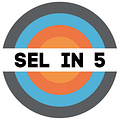This month, we discuss the importance of environments and shifting systems.
3 SEL Leadership Thoughts
The environment produces the behavior. We can treat the behavior—but, if the environment persists unchanged, we will never create true pathways to well-being and support. [Tweet This]
—
When thinking about creating transformational change, are we asking: “what do I have to do?” Or are we focusing on: “who do I have to become?” [Tweet This]
—
Using common language with staff and students is critical—especially when it comes to social and emotional learning. There needs to be consistency across the school community. Is everyone speaking the same language when it comes to emotions? To behaviors? Is this terminology being shared with parents and extended into student’s homes? By formalizing the language we use we give students a supportive system for self-advocating and asking for help; we give families more comfort to engage; and we give staff the terms to collaborate about how to support students in more asset-based ways. [Tweet This]
2 Quotes from SEL Leaders
“Historically, districts have tried to explicitly identify issues—take bullying or attendance—and find individualized programs that address that one issue. They might see a reduction or improvement in that one area but it’s not truly addressing the root cause. We cannot continue to just focus on individual issues that come up and try to respond to them with one-off interventions. It is not sustainable for this to fall on the shoulders of educators without shifting systems.” – Corey Notestine, Director of Implementation & Improvement at CharacterStrong [Tweet This]
—
“Young people live up or down to expectations we set for them. They need adults who believe in them unconditionally and hold them to the high expectations of being compassionate, generous, and creative.” – Kenneth Ginsburg, MD [Tweet This]
1 Question to Reflect On
Are we focusing on “fixing” students or shifting systems?
—
If you enjoyed that, please consider sharing SEL in 5 with others.
Until next month,
Nick Woolf
Author of SEL in 5
Founder of Inside SEL
p.s. here’s what else I’m reading:

